Salvadoraceae
| Salvadoraceae | ||||||||||||
|---|---|---|---|---|---|---|---|---|---|---|---|---|

Salvadora oleoides , illustration |
||||||||||||
| Systematics | ||||||||||||
|
||||||||||||
| Scientific name | ||||||||||||
| Salvadoraceae | ||||||||||||
| Lindl. |
The Salvadoraceae are a family of plants in the order of the cruciferous (Brassicales).
description

They are shrubs with very small, simple leaves or small trees with opposite, very leathery, simple leaves. Stipules are only rudimentary . They are xerophytes . Few species climb.
The plants can be mono or dioecious. The flowers can be unisexual or hermaphroditic. The mostly four-fold flowers are small. The sepals (sepals) are fused. The petals are free. There are either one or two fertile stamen circles, each with usually four (rarely five) stamens . Two carpels have become a top permanent ovary grown. The fleshy fruits are berries or stone fruits , they are mostly solitary.

distribution
They mostly occur in dry climates . There are areas in Africa (including Madagascar ), on the Indian subcontinent , in Southeast Asia and in the western Malay Archipelago .
use
Mustard oil glycosides are present. The species Azima tetracantha contains piperidine alkaloids ( azimin , azcarpin , carpain ), flavonoids and various glycosides . It is a food and medicinal plant in Africa, Madagascar and India, where it is used for toothache and it has anti-inflammatory properties. The arak tree ( Salvadora persica ) is also widely used in oral hygiene, e.g. B. in the Middle East, where it is known by the rural population as miswak ("Kaustock").
Systematics
In the family of the Salvadoraceae there are three genera with eleven (to twelve) species:
- Azima Lam. : With about four types; they occur from Africa to Hainan, the Philippines and the Lesser Sunda Islands .
- Dobera Juss. : With two kinds; they occur in tropical East Africa and from southern Arabia to northwest India.
-
Salvadora L .: With five species that occur from Africa to tropical Asia, including:
- Salvadora Oleoides Decne. : It occurs in southern Iran, Pakistan and India.
- Toothbrush tree or arak tree ( Salvadora persica L. ).
swell
- The the Salvadoraceae with the family APWebsite (Engl.)
- Description of the Salvadoraceae family at DELTA. (engl.)
- Hua Peng & Michael G. Gilbert: Description and identification key of the Chinese taxa in the Flora of China. (engl.)
- David John Mabberley: Mabberley's Plant-Book. A portable dictionary of plants, their classification and uses . 3rd ed. Cambridge University Press 2008. ISBN 978-0-521-82071-4
Individual evidence
- ↑ RN Bennett et al .: Profiling glucosinolates, flavonoids, alkaloid, and other secondary metabolites in tissues of Azima tetracantha L. (Salvadoraceae). J. Agric. Food Chem. 52/19/2004. Pp. 5856-62. PMID 15366832
- ^ SS Hebbar et al .: Ethnomedicine of Dharwad district in Karnataka, India - plants used in oral health care. J Ethnopharmacol . 94 / 2–3 / 2004. Pp. 261-6. PMID 15325728
- ^ TS Ismail et al .: Anti-inflammatory activity of Salacia oblonga Wall. and Azima tetracantha Lam. J Ethnopharmacol. 56/2/1997. Pp. 145-52. PMID 9174976
- ↑ Hua Peng & Michael G. Gilbert: Salvadoraceae. In: Flora of China, vol. 11, Salvadoraceae. Azima
- ^ Salvadora in the Germplasm Resources Information Network (GRIN), USDA , ARS , National Genetic Resources Program. National Germplasm Resources Laboratory, Beltsville, Maryland. Retrieved October 6, 2018.

